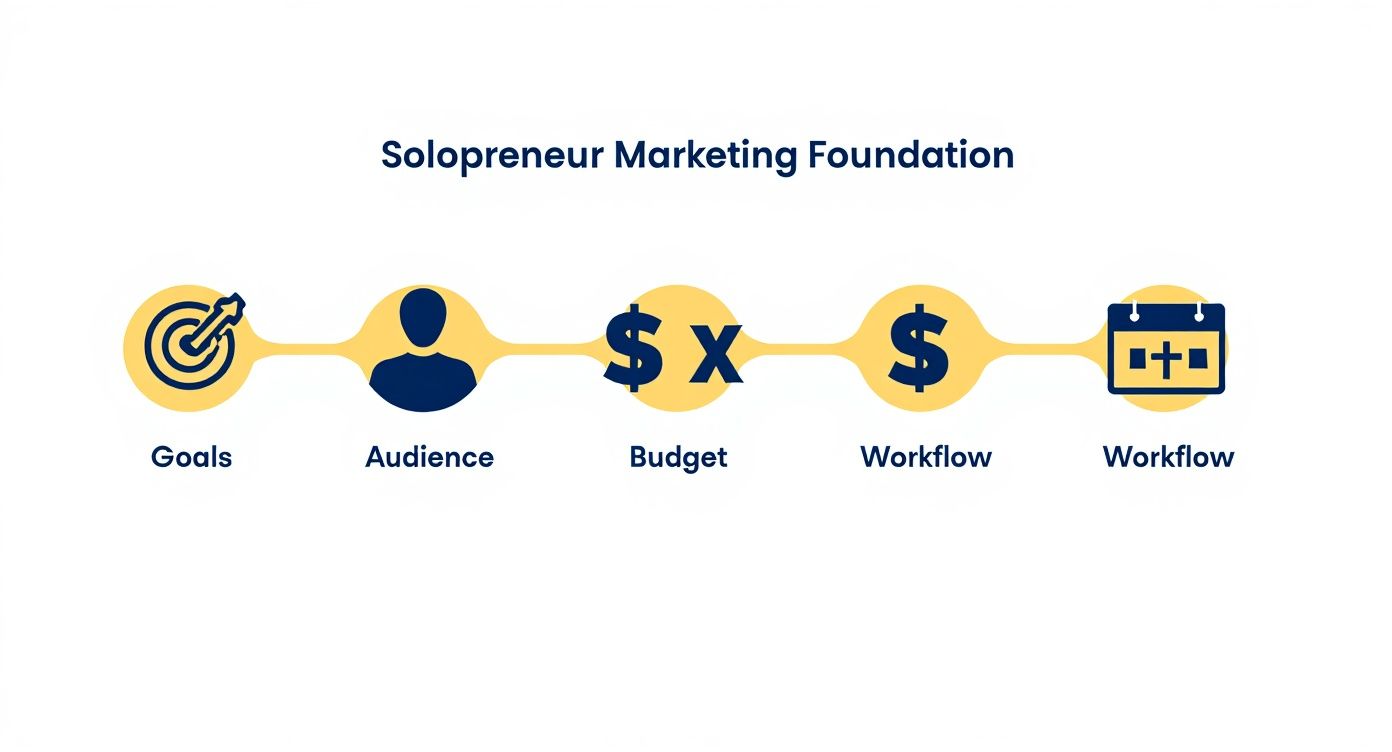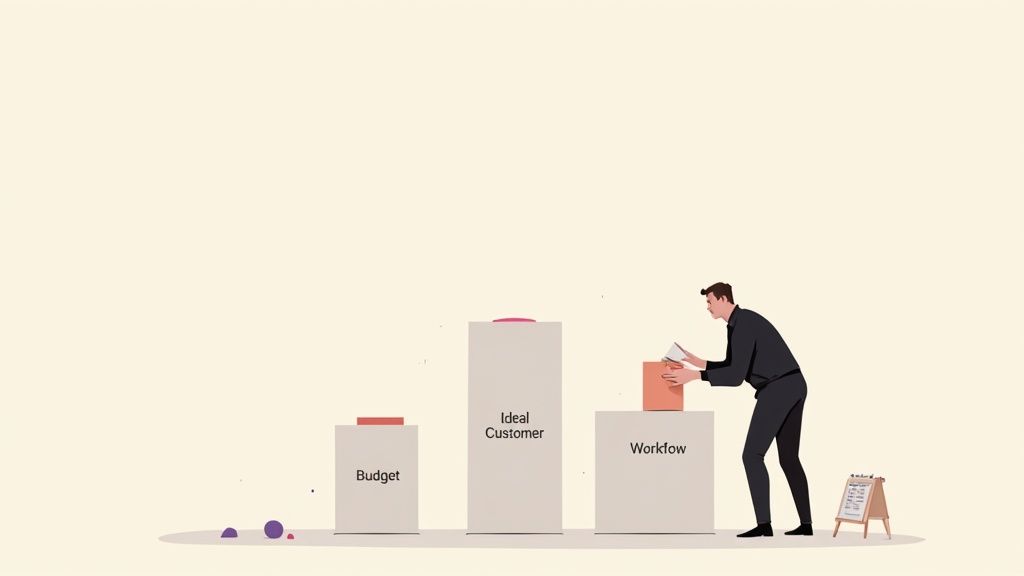marketing for solopreneurs: A Smarter Marketing Guide

Trying to do marketing for solopreneurs without a solid foundation is a recipe for burnout. It's easy to get distracted by the latest "growth hack" or shiny new tactic, but real progress comes from a simple, repeatable system. Before you even think about which channels to use, you need to lock in your goals, figure out exactly who you're selling to, set a realistic budget, and build a weekly workflow you can actually stick to.
This initial setup work is what separates scattered activity from focused, intentional growth.
Building Your Marketing Foundation
Jumping straight into posting on social media or running ads without a plan is like trying to build a house without a blueprint. You might get a few walls up, but it's going to be wobbly and inefficient. As a solopreneur, your time and focus are your most precious resources. A solid foundation makes sure every single thing you do is deliberate, measurable, and pushing you toward your real business goals.
This isn't about being busy; it's about being effective. The flowchart below breaks down the four pillars that hold up any successful solopreneur marketing plan.

As you can see, it all starts with clear goals. From there, you can define your audience, allocate your budget, and finally, structure a workflow that keeps you on track week after week.
Set Actionable Goals and KPIs
Let's be honest: vague goals like "get more clients" are useless. They don't give you any direction. You need specific, measurable targets that you can actually work toward.
Instead of "increase sales," your goal should sound more like, "Acquire three new retainer clients with an average project value of $2,000 per month by the end of Q3." Now that's a target you can build a plan around.
Key Performance Indicators (KPIs) are just the numbers that tell you if you're winning or losing. For a solo operator, these are the essentials:
- Leads Generated: How many new potential customers are you getting in the door each week?
- Conversion Rate: What percentage of those leads are actually turning into paying clients?
- Customer Acquisition Cost (CAC): How much are you spending in time and money to land one new customer?
- Website Traffic: How many unique visitors are hitting your key landing pages?
Tracking these keeps you honest and helps you make decisions based on data, not just a gut feeling.
Define Your Ideal Customer Profile
You cannot market to everyone. Trying to will just dilute your message and drain your bank account. The key is to create an Ideal Customer Profile (ICP)—a super-detailed description of the one perfect customer for your business.
Get specific. What's their industry, company size, and job title? What are the nagging problems that keep them up at night? Where do they hang out online to find solutions?
By niching down and focusing all your marketing on a specific ICP, you instantly transform from a generalist into a sought-after specialist. This shift is what allows you to command premium rates, because clients will always pay more for an expert who truly understands their world.
Once you know exactly who you're talking to, every other marketing decision—from the content you write to the platforms you use—becomes ten times easier.
Establish a Sustainable Workflow
For solopreneurs, consistency is the ultimate competitive advantage. A sustainable weekly workflow is what keeps your marketing engine running smoothly without leading to total burnout. I'm a big fan of using a flexible tool like Notion to build a simple, custom marketing dashboard.
Having a visual command center like this lets you see everything at a glance—from content ideas to active outreach campaigns. It makes the entire operation feel manageable for a team of one. If you need something even simpler for daily to-dos, a tool like Todoist is fantastic for creating recurring marketing checklists.
This level of organization is what separates the pros from the amateurs. In fact, despite working alone, over 75% of solopreneurs manage to become profitable in their first year. A surprising number do quite well, with recent data showing about 20% earn between $100,000 and $300,000 annually. That's the power of smart systems and relentless focus.
Choosing where to spend your time is the next big decision. This matrix can help you quickly assess which channels might be the best fit for your business model and resources.
Solopreneur Marketing Channel Selection Matrix
| Marketing Channel | Best For (Business Type) | Time Commitment | Budget Required | Key Metric |
|---|---|---|---|---|
| SEO & Content | Consultants, SaaS, Coaches | High (upfront) | Low to Medium | Organic Traffic, Keyword Rankings |
| Cold Outreach | B2B Services, Agencies | Medium | Low | Positive Reply Rate |
| B2B Freelancers, Consultants | Medium | Low to High (ads) | Profile Views, Connection Requests | |
| Faceless YouTube | Course Creators, Affiliates | High | Low | Watch Time, Subscriber Growth |
| Paid Ads (Social/Search) | E-commerce, Info Products | Low (to manage) | High | Cost Per Acquisition (CPA) |
| Community Building | Coaches, Membership Sites | High | Low | Engagement Rate, Member Growth |
Use this table as a starting point. The goal isn't to be everywhere, but to dominate one or two channels that align perfectly with your business, your budget, and the amount of time you can realistically commit.
Winning the Long Game with SEO

Let’s be honest: SEO is the ultimate long-term play for any solopreneur. This isn't about getting a viral hit overnight. It's about methodically building a digital asset that works for you 24/7, pulling in qualified leads while you’re asleep, on vacation, or busy with client work.
Think of it as your best, most reliable salesperson—one who never asks for a commission.
The real magic of SEO is that it compounds. The work you put in today—finding the right keywords, creating genuinely helpful articles—can pay you back for years. Paid ads are great, but they stop the second you turn off the spend. A top-ranking blog post? That can bring in traffic and leads indefinitely.
This staying power is everything in today's market. Entrepreneurship is booming, with roughly 20% of adults globally starting or running new businesses. With the startup ecosystem growing by about 21% annually, you need a sustainable way to cut through the noise. SEO is that way.
Finding What Your Customers Are Actually Searching For
The entire foundation of good SEO rests on one thing: understanding the exact words and phrases your ideal customers type into Google. This isn't a guessing game. It's about uncovering their intent with a bit of straightforward keyword research.
Your goal is to find what we call "long-tail keywords." These are longer, more specific phrases that signal someone is much closer to making a decision. For instance, instead of trying to rank for the hyper-competitive term "marketing consultant," you'd aim for something like "marketing consultant for SaaS startups."
This focused approach delivers two huge wins:
- Less Competition: Far fewer businesses are trying to rank for those specific phrases, giving you a real chance to get to page one.
- Higher Conversion Rates: The person searching for a niche solution is a much warmer lead than someone just browsing a general topic.
A great way to start is to just write down the top ten questions your clients always ask you. I guarantee each of those questions is a valuable keyword you can build a piece of content around.
Mastering the On-Page SEO Essentials
Once you’ve got your keywords, the next step is to weave them into your website’s content naturally. This is called on-page SEO, and it’s way less technical than it sounds. It’s really just about making sure both people and search engines can easily understand what your page is about.
For every piece of content you create, just focus on these key areas:
- A Killer Title: Your title tag is the first thing people see in the search results. It has to include your main keyword, but more importantly, it has to be compelling enough to make someone want to click.
- A Clear Meta Description: This is that little snippet of text under your title on Google. Think of it as a mini-ad for your content—tell them why they should click on your link over all the others.
- Genuinely Helpful Content: Your article or page must solve the user's problem, period. Google's number one job is to give its users the best possible answer. If your content is that answer, you'll be rewarded.
Tools can take a lot of the guesswork out of this. Content optimization software like Frase, for example, helps you structure your writing by analyzing what's already ranking for your target keyword.

As you can see, an interface like this lets you compare your draft against the top-ranking competitors in real-time. It shows you topic gaps and important terms you might have missed, helping you build content that's truly comprehensive.
Key Takeaway: Solid on-page SEO isn't about "keyword stuffing." It’s about creating a fantastic, user-friendly experience that directly answers a specific search query. When you help the user, you help Google see your content as an authority.
If you’re a service-based solopreneur, you also need to get serious about local SEO. Optimizing your Google Business Profile with accurate info, your list of services, and a steady stream of good reviews can put you on the map—literally. It's one of the fastest ways to turn local searches into actual customers.
If you want to dive deeper into the nuts and bolts, check out our full guide on how to do search engine optimization yourself.
Connecting Through Smart Outreach
SEO is a long game. It's your engine for bringing in leads down the road, but sometimes you need to get out there and make things happen now. As a solopreneur, your personal brand is your biggest advantage in direct outreach. This isn't about blasting a thousand inboxes with spam; it's about making genuine, one-to-one connections at scale using smart, repeatable systems.
This proactive approach is the difference between waiting for business and creating it. You're in the driver's seat, targeting your ideal clients with a message that hits home. With the right tools and a bit of planning, you can build a powerful outreach machine that still has the personal touch only you can provide.

Building Your Ideal Client List
Let's be blunt: effective outreach starts with a high-quality list. Garbage in, garbage out. The goal isn't to scrape thousands of random contacts. It's to pinpoint a few hundred perfect-fit prospects who match your Ideal Customer Profile.
This is where modern tools become your superpower.
Platforms like Apollo are indispensable here. They let you slice and dice a massive database by industry, company size, job title, tech stack, and dozens of other filters. For instance, a freelance Webflow developer could instantly pull a list of Marketing Managers at B2B tech companies with 50-200 employees that don't currently use Webflow. That level of precision is an absolute game-changer.
If you need to get even more granular, a tool like PhantomBuster lets you scrape data from places like LinkedIn groups or event attendee lists. This helps you build hyper-relevant lists for specific campaigns.
Crafting an Outreach Cadence That Works
Once you have your list, you need a plan. A "cadence" is just a fancy term for a pre-planned sequence of touchpoints—usually a mix of emails and LinkedIn pings. The idea is to be persistent without being a pest.
Automation platforms are your best friend here. Tools like Lemlist or Brevo let you build out these sequences and personalize them at scale. You can set them up to automatically send follow-ups if someone doesn't reply, and the whole thing stops the moment they do. This way, nothing slips through the cracks, and you're not stuck manually tracking everything.
For a deeper dive, check out our full playbook on setting up Apollo.io sequences for automated outreach.
A simple, effective cadence is all you need to get started. Here's a sample you can steal and adapt.
Sample 3-Step Cold Email Cadence
| Step | Email Subject Line | Core Message | Call to Action |
|---|---|---|---|
| Email 1 | Quick question about [Company Name] | A brief, personalized observation about their business and a hypothesis about a problem you can solve. | A low-friction question like, "Is this a priority for you right now?" |
| Email 2 | Re: [Original Subject] | Add a piece of value, like a link to a relevant case study or a helpful article you wrote. | "No worries if not, just wanted to share something that might be useful." |
| Email 3 | My final follow-up | The "breakup" email. Politely state this is your last message and reiterate your value proposition simply. | "If you're ever looking for help with [your service], I'd be happy to chat." |
This sequence shows respect for your prospect's time while still giving you a few solid shots at making a connection.
Leveraging LinkedIn for Authority and Leads
LinkedIn is way more than an online resume. It’s the single most powerful B2B networking platform on the planet, and for solopreneurs, it's a non-negotiable part of your marketing for solopreneurs playbook.
Your LinkedIn profile isn't about you; it's about your ideal client. Your headline and "About" section should speak directly to their pain points and position you as the solution. Instead of "Freelance Writer," try "Helping SaaS Companies Turn Blog Readers into Demo Requests."
Beyond just having a solid profile, your activity is what really moves the needle. Don't just broadcast your services. Focus on these three activities instead:
- Share Valuable Content: Post short, insightful text posts, comment on trending topics in your industry, and give away your expertise for free. This builds authority and brings people to you.
- Engage Meaningfully: Spend 15 minutes a day leaving thoughtful comments on posts from your ideal clients and industry leaders. This is how you get on their radar in a natural, non-salesy way.
- Participate in Groups: Find 2-3 active LinkedIn Groups where your ideal clients hang out. Answer questions and contribute to discussions to establish yourself as a helpful expert.
This approach transforms LinkedIn from a passive profile page into an active lead-generation machine, creating the real connections that will fuel your business.
You Don't Need a Content Team to Look Like One
Let's get one thing straight: content marketing as a solopreneur isn't about out-producing the big guys. It’s about being smarter.
The most common trap I see people fall into is thinking they need to be a content machine, pumping out brand-new material every single day for every single platform. That’s a one-way ticket to burnout. The reality? You can build a powerful online presence with just one or two core pieces of content a month. The secret is a simple philosophy: Create Once, Distribute Everywhere.
This just means you treat every big piece of content—a blog post, a video, a webinar—as the "parent" asset. From that one piece, you can spin off dozens of smaller, platform-specific posts. It’s not about being on every channel; it’s about making one great idea work harder for you across the few channels that actually matter.
Turning One Idea Into a Dozen Assets
Let's make this real. Imagine you write a single, in-depth blog post—say, 1,500 words—that solves a huge pain point for your ideal client. That one article is your raw material. Now, let's see how much mileage we can get out of it without starting from scratch.
- Short-Form Video: Pull out three key takeaways from the post. Boom. Those are your scripts for three separate 60-second vertical videos. You don't even have to show your face.
- LinkedIn Posts: Skim the article and extract 5-7 compelling quotes, stats, or actionable tips. Each one becomes a standalone text post or a simple graphic for LinkedIn.
- Newsletter: Your blog post is now the main feature in your next email newsletter. You can either include the full text or drop in a summary with a link back to your site.
- Twitter/X Thread: Break down the main arguments of your post into a 10-tweet thread. Each tweet covers a single sub-point, hooking the reader from one to the next.
Just like that, one blog post that took you a few hours has generated over a dozen pieces of content. You’ve got enough material to post consistently for weeks. You’re not creating more; you’re distributing smarter.
The Rise of the Faceless YouTube Channel
Video is incredible for building trust, but let’s be honest—most solopreneurs hate the idea of getting in front of a camera. This is exactly where a "faceless" YouTube channel comes in. Here, the focus is 100% on the value of the content—screen recordings, animated text, stock footage—not on you.
This approach completely lowers the barrier to entry. You can create super high-value tutorials or explainer videos with simple screen-capture software. And for the audio? AI voiceover tools have gotten shockingly good. A platform like Murf.ai has a library of natural-sounding voices, while Eleven Labs is famous for its ability to clone voices and create really expressive narration.
The key to a winning faceless channel is delivering insane value. Since you aren't relying on personal charisma, the quality and utility of your information have to be absolutely top-notch. It’s all about teaching, solving problems, and proving you know your stuff.
Your Bare-Bones Content Creation Toolkit
To make this efficient workflow a reality, you need the right tools. But you don't need a massive, expensive tech stack. A few carefully chosen tools can handle the most time-consuming parts of creation and distribution, freeing you up to focus on the core ideas.
For example, turning a long video into social clips used to take hours. Now, AI-powered tools have made it a total game-changer. Take a look at the interface for a tool I use called Opus Clips.
You literally just paste a YouTube link. The AI finds the most engaging parts, automatically reframes them for vertical viewing, and adds captions. A process that used to be a full day of editing now turns one long video into ten or more ready-to-post social clips in a matter of minutes.
Here’s a lean toolkit to get you started:
- Writing Assistance: Use QuillBot to rephrase sentences, check grammar, and make your writing punchier. It's like having a co-writer on standby to polish your drafts.
- Content Repurposing: As I mentioned, Opus Clips is a must-have for turning long videos into dozens of shareable clips for TikTok, Reels, and YouTube Shorts.
- Scheduling & Distribution: A tool like SocialBee lets you schedule all your repurposed content in advance. You can set up content categories and a recurring schedule, which guarantees a consistent online presence without you having to manually post every day.
This combination—a smart philosophy and a lean toolset—is how you build sustainable marketing as a one-person show. It allows you to build authority and stay top-of-mind without letting content creation eat your business alive.
Building Your Solopreneur Tech Stack
As a solopreneur, your time is your most valuable—and most limited—asset. You can't just work more hours to grow. The only way to scale your impact, and your income, is by building smart systems with the right technology.
A well-chosen tech stack isn't about collecting shiny new tools. It's about creating an operational backbone for your business, one that automates the grunt work and frees you up to focus on what actually matters.
This isn't just a "nice-to-have" anymore; it's fundamental to modern marketing for solopreneurs. The solopreneur economy is a beast, with freelancers in the U.S. alone kicking in around $1.27 trillion to the economy. This boom is powered by tech that lets a single person run a business that once would've required a whole team.
The goal here is to build a lean, powerful set of tools that talk to each other, creating a business that practically runs itself, even when you step away from the keyboard.
Core Functions Your Tech Stack Must Cover
Every solo business, at its core, needs to do four things: attract leads, nurture them, close deals, and manage the money. Your tech stack should map directly to these functions without making your life a tangled mess of logins and subscriptions.
Don't fall into the trap of grabbing a different tool for every tiny task. Look for platforms that can wear multiple hats.
Your stack needs to handle these essentials:
- Lead Capture & Nurturing: This is your digital front door. You need a way to build landing pages that convert and set up automated email sequences to welcome new subscribers.
- Sales & Outreach: You need a system to find potential clients and reach out consistently. Automation is your best friend here, keeping your pipeline full without you having to manually chase every lead.
- Content & Social Media: A steady online presence builds trust and authority. Your tools should make it dead simple to schedule content weeks or months in advance.
- Operations & Finance: From getting contracts signed to sending invoices, these are the tools that keep the lights on and the business running smoothly in the background.
The magic happens when these tools integrate, letting you build simple workflows that save you hours every week.
Building Your Marketing and Sales Engine
Your marketing engine should be built on automation. A potential customer should be able to discover you, sign up for your newsletter, and get their first email without you lifting a finger.
For this, an all-in-one platform like Brevo is a phenomenal starting point. It bundles email marketing, landing pages, and a lightweight CRM into one affordable package. This lets you set up simple but powerful workflows, like automatically adding a new lead from a landing page to a welcome email series.
If you find you need more advanced landing page features like A/B testing down the line, you can always layer in a dedicated tool like Leadpages or Unbounce.
This screenshot from Brevo shows just how intuitive their workflow builder is—a must-have feature for any solopreneur.

This kind of visual interface lets you map out an entire customer journey, triggering different actions based on what a user does. It's how you personalize your marketing at scale, on autopilot.
When it comes to proactive sales, an AI-powered tool like AiSDR can handle your cold outreach, while a social media scheduler like SocialBee keeps your content pipeline flowing. Combining these inbound and outbound tools gives you a complete lead-generation machine. To see how all the pieces fit together, check out our full guide on the best tools to start an online business.
Key Insight: The best tech stack is the one you actually use. Start with one or two core tools that solve your biggest headaches. Master them, build a few simple automations, and only add new software when you have a clear, painful problem it can solve. Complexity is the enemy of a one-person show.
Essential Tools for Business Operations
Beyond getting clients, you need a few tools to handle the day-to-day nuts and bolts. Trying to manage this stuff manually is a fast track to burnout and lost time that should be spent on client work or growing the business.
- Financial Management: Ditch the personal spreadsheet. A proper accounting tool like Xero is built for small businesses, making it easy to track income, manage expenses, and not have a panic attack when tax season rolls around.
- Contract Management: Emailing PDFs back and forth for signatures is slow and looks amateur. A service like Sign now lets you send, sign, and store legally binding contracts online in minutes.
- Project Management: To keep client work and your own projects from spiraling into chaos, you need a flexible command center. Notion is incredible for building custom dashboards, while Todoist is perfect for straightforward to-do lists and recurring checklists.
These operational tools are the unsung heroes of an efficient solo business. They let you deliver professional-grade service and stay in control without getting buried in admin. Think of your tech stack as your first and most important hire.
Your Top Solopreneur Marketing Questions, Answered
Jumping into marketing as a one-person show can feel like you've been handed a puzzle with half the pieces missing. You know the end goal, but where do you even start? Let's clear the fog with some straight-up answers to the questions I hear most often from solo founders.
How Much Should a Solopreneur Spend on Marketing?
First, throw out that old rule about spending a fixed percentage of your revenue. It’s outdated. The only number that matters is your Customer Acquisition Cost (CAC).
Here's the new model: figure out what a new client is worth to you over their lifetime. Then, decide how much of that you're willing to pay to get them in the door. It's a simple, results-driven way to budget.
Not sure where to begin? Start small. A budget of $100-$300 a month is more than enough to test one specific channel, like a handful of LinkedIn ads or a tiny Google Ads experiment. Once something clicks and you see a positive return, you can pour fuel on the fire by reinvesting the profits.
What's the Most Effective Marketing Channel for a Beginner?
This will vary, but if I had to bet on a winning combo for someone starting from scratch, it's this: a perfectly optimized LinkedIn profile paired with daily activity in 2-3 niche online communities.
Why this approach? It costs you zero dollars—only your time—and it hits multiple targets at once:
- It builds authority. You become the go-to expert by genuinely helping people and answering questions.
- It creates real connections. You get to have actual one-on-one conversations with people who could become clients.
- It generates warm leads. After seeing you provide value, people will naturally click on your profile, which should be set up to guide them straight to your services.
How Do I Market Myself with No Portfolio or Case Studies?
Ah, the classic chicken-and-egg dilemma. The solution is simpler than you think: you need to manufacture your own proof.
Offer your services to one or two clients at a steep discount—or even for free. But there’s a catch. In exchange, you need two non-negotiable things: a glowing, detailed testimonial and full permission to build a public case study around the project.
Another great move is to create content that showcases your brain. Write a ridiculously detailed blog post that breaks down your exact process for solving a common client problem. It’s a portfolio of your thinking, and it proves you can do the work long before you have a client list.
The goal isn't just to land a client; it's to acquire a success story. A powerful testimonial from a happy client is a marketing asset that will pay dividends for years, attracting higher-paying clients who are looking for proven results.
Treat these first projects like they're your most important marketing investment ever. Over-deliver like crazy, document everything, and use that early work as the social proof that will launch your entire business.
Common Questions for Solopreneur Marketers
Getting started is often the hardest part. Here are some quick answers to the most pressing questions that come up when you're handling marketing all on your own.
| Question | Answer |
|---|---|
| Is it better to focus on one marketing channel or many? | One. Master a single channel until it produces consistent results before you even think about adding a second. Spreading yourself too thin is a recipe for burnout and mediocre outcomes. |
| How long does it take to see results from marketing? | It depends on the channel. Paid ads can show results in days, while SEO and content marketing can take 6-12 months. The key is to pick a channel that fits your timeline and stick with it. |
| What's the biggest marketing mistake solopreneurs make? | Inconsistency. They start a blog, post for a month, then stop. They run ads, don't see immediate ROI, and quit. The solopreneurs who win are the ones who show up consistently, even when it feels like no one is watching. |
| Do I need a fancy website to start marketing? | No. A simple, clean one-page site that clearly explains what you do, who you do it for, and how to contact you is enough. A well-optimized LinkedIn profile can even serve as your primary "website" in the early days. |
Hopefully, these answers give you a clearer path forward. The key is to stop overthinking and start doing. Pick one thing, do it well, and build from there.





